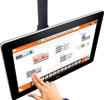

Whereas pointing devices such as the mouse and trackballs have been common in the office for decades, they have never been able to take hold in industrial automation. In these environments, there has instead been a consistently strong trend towards touch screen monitors. These solutions are available using many different types of technologies depending on environmental conditions and the application at hand. As such, they have come quite a long way. Touch-sensitive screens have even broken through in industries where hygiene plays a large role, for example in foodstuffs and pharmaceuticals. “Touch screens will never completely replace devices with physical keys,” believes Raimund Ruf, HMI business manager at B&R. “Nevertheless, their penetration into more and more areas will continue due to their overall versatility. At the same time, we are seeing much more emphasis being placed on user ergonomics, whether in how panel hardware is arranged or in the design of the user interface.”
Multi-touch technology offers the potential for the next big leap in innovation in the field of machine manufacturing and promises a significant increase in user friendliness.
Two-finger ergonomics
The multi-touch technology we are familiar with from smartphones is based on the same analog resistive or projected capacitive platforms used for single touch; it has simply been enhanced to include multi-touch features. Unlike traditional touch screen designs, these systems are able to recognise and evaluate the position of several touch contacts taking place at the same time. For consumers and office workers, this function is perhaps most used for zooming in or out on the screen using a two finger pinching or un-pinching gesture.
“There are very interesting possibilities for using multi-touch in industrial environments,” says Ruf. “It would be a mistake to dismiss this technology as a gimmick when it actually has the potential to improve user ergonomics.”
It goes without saying that visualisation software can also take advantage of zoom functionality. However, as an HMI expert, Ruf sees this application being used more with commissioning and maintenance than anywhere else. He is convinced that multi-touch technology will be utilised to simplify system operation and make operation safer at the same time. “One possible scenario would be where the operator uses one hand to open up a menu while using the other to set parameters,” he explains. “This eliminates the need to jump back and forth between sub-menus and also increases overall clarity in the application.”
Faster and safer
Multi-touch panels enable the implementation of innovative control concepts based on simplified interfaces that make it possible to work more intuitively. The operator is able to get where he needs to go faster since complex menu layers can be eliminated. This might be made possible by scrollable button toolbars, for example. Handling lists would also be simplified since the operator could simply scroll through them without having to rely on narrow scrollbars. Along with swipe gestures for changing pages, this would make processes for operating personnel much more intuitive as well as faster than the current method of working sequentially with single-touch systems. The time needed to train personnel would also be reduced. Just as important as improving speed across the board is increasing operational safety. Faulty operations caused by accidental contact can be avoided, for example, by requiring a second button to be pressed simultaneously with the other hand before a certain action can take place. “Even if this would not completely replace failsafe two-hand operation, multi-touch technology can be used in this way to prevent critical operating steps from being carried out unintentionally, explains Ruf.
“Many companies in the classic machine manufacturing industry have expressed interest in this solution, as well as scada system manufacturers where this technology would be advantageous for process control. I am convinced that multi-touch will bring about dramatic changes in ergonomic features,” he concludes.
For more information contact Mike van Tonder, KlareTech, +27 (0)11 958 0222, [email protected], www.klaretech.com
© Technews Publishing (Pty) Ltd | All Rights Reserved